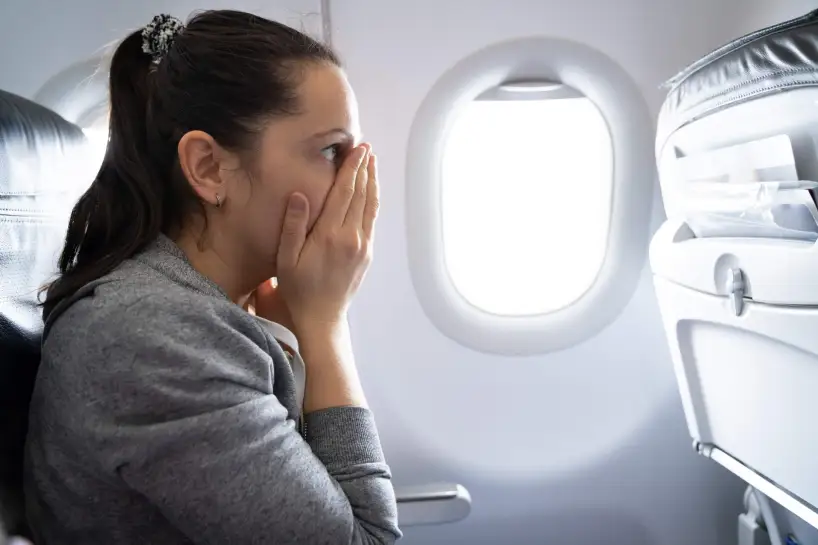The Manhattan Center for Cognitive-Behavioral Therapy offers fear of flying treatment. This therapy is targeted to those who have become reliant on alcohol or prescription medications to fly. It’s also effective for those who’d like to avoid that!
Fear of Flying
Despite numerous technological advancements to improve the safety and accessibility of traveling by airplane, 6.5% of Americans today live with a fear of flying. Even celebrities and athletes admit to flying woes!
This phobia–also known as pteromerhanophobia or aviophobia–may wreak havoc in people’s lives by causing anxiety around planning vacations, family visits, long-distance relationships, or work-related travel.
Coping with a Fear of Flying
Those with a fear of flying may have strong negative reactions before and during a flight. They might simply avoid traveling by air altogether. For people who continue to fly despite their fears, strategies are often employed that work reasonably well–in the short-term.
Many short-term solutions include engaging in distractions like playing games, watching a movie, or checking social media. Others include using sleeping aids or anti-anxiety medication; ordering overpriced alcohol to ease anxiety; or simply gripping the armrest with eyes tightly shut to avoid scary thoughts and feelings. These techniques may help a person “survive” the flight. Unfortunately, they don’t do much to chip away at the actual fear of flying.
Thankfully, this phobia can be treated effectively so air travel is much more pleasant and manageable. Cognitive-behavioral therapy (CBT), in particular, is effective for phobias including fear of flying. (More on this below.)
Understanding the Fear
It is important to understand what is triggering the fear of flying before considering how to treat the fear. For many people, anxiety about flying is actually a fear of closed spaces (claustrophobia) or a fear of heights (acrophobia). Others might be afraid of having a panic attack or losing control of themselves while on board the aircraft. Having panic attacks on planes is quite common, and can be an awful experience.
For others, the fear of flying is really about the fear of crashing or experiencing terrorism. For these folks, extreme anxiety around takeoff and landing is common.
The Role of Thoughts
Whatever the underlying trigger may be, there is often some erroneous and unhelpful thinking playing a role in maintaining such fears. Identifying these thoughts is the first step toward overcoming the phobia.
After pinpointing the inaccurate thoughts, it’s helpful to “poke holes” in these thoughts and replace them with more rational beliefs. This challenges the fears that arise when thinking about flying. This may seem like a daunting task because most people know that their fears are irrational and that, logically, flying is safe. However, remembering what is rational in the moment is the key to combating these fears.
Therapy for Fear of Flying
Let’s say that someone has an irrational fear of the plane malfunctioning, and crashing. Learning about how planes operate, routine plane maintenance, and which are normal plane noises may help allay fears of flying. Another strategy is to examine the statistics of plane crashes and the evidence from that person’s previous flights. These strategies are often part of cognitive-behavioral therapy for fear of flying. Working with a CBT therapist one these strategies is typically much more effective than doing them on your own. These strategies typically help one come to realize that the chances of being in a crash due to a defective plane are smaller than originally believed.
A CBT therapist will often work with people to create rational statements such as, “Flying is the safest way to get from point A to point B.” Integrating such new thought patterns into one’s inner monologue can limit the impact of anxious thoughts as they arise. This strategy often helps kick-start the development of a new helpful travel routine.
Systematic Desensitization
For those who avoid airplane travel all together, the therapist may utilize a method of treatment called “systematic desensitization.”
In this form of CBT, the therapist and client will assemble a “fear hierarchy” of scary situations or environments. This is a list, ranked from the least to most anxiety-provoking, culminating with the goal of boarding a plane at the top. The therapist gradually exposes the client to the feared situations on the hierarchy until the situations don’t feel frightening. Eventually, the client reaches his goal of boarding a plane.
For example, someone who has an extreme fear of takeoff might first watch videos of planes taking off. She might listen to prerecorded airplane noises to get used to the various sounds that occur during takeoff. Then, she might find a computer simulator to expose herself to the physical conditions of the airplane. She would continue working her way up the fear hierarchy. Eventually she will be ready to purchase a plane ticket and board the plane.
How to Get Fear of Flying Treatment in NYC
Remember that facing any fear takes courage and time. Seeking professional help from a cognitive-behavioral therapist may expedite recovery from a fear of flying.
Contact us if you’d like to address your fear of flying. With some work, traveling by plane can go from being dreaded to being mundane.
Subscribe to the Manhattan Center for Cognitive-Behavioral Therapy blog!









